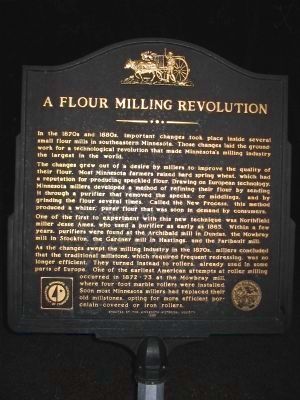Near Northfield in Rice County, Minnesota — The American Midwest (Upper Plains)
A Flour Milling Revolution
The changes grew out of a desire by millers to improve the quality of their flour. Most Minnesota farmers raised hard spring wheat, which had a reputation for producing speckled flour. Drawing on European technology, Minnesota millers developed a method of refining their flour by sending it through a purifier that removes the specks, or middlings, and by grinding the flour several times. Called the New Process, this method produced a whiter, purer flour that was soon in demand by consumers.
One of the first to experiment with this new technique was Northfield miller Jesse Ames, who used a purifier as early as 1865. Within a few years, purifiers were found at the Archibald mill in Dundas, the Mowbray mill in Stockton, the Gardner mill in Hastings, and the Faribault mill.
As the changes swept the milling industry in the 1870s, millers concluded that the traditional millstone, which required frequent redressing, was no longer efficient. They turned instead to rollers, already used in some parts of Europe. One of the earliest American attempts at roller milling occurred in 1872-73 at the Mowbray mill, where four-foot marble rollers were installed. Soon most Minnesota millers had replaced their old millstones, opting for more efficient porcelain-covered or iron rollers.
Erected 1995 by the Minnesota Historical Society.
Topics and series. This historical marker is listed in this topic list: Industry & Commerce. In addition, it is included in the Minnesota Historical Society series list. A significant historical year for this entry is 1865.
Location. 44° 27.037′ N, 93° 17.381′ W. Marker is near Northfield, Minnesota, in Rice County. Marker can be reached from Interstate 35 at milepost 68,, 1˝ miles north of Millersburg Boulevard (County Road 1), on the right when traveling north. Marker is at the north bound Heath Creek Rest Area. Touch for map. Marker is in this post office area: Dundas MN 55019, United States of America. Touch for directions.
Other nearby markers. At least 8 other markers are within 11 miles of this marker, measured as the crow flies. Millersburg & the Northfield Bank Robbery (approx. 2˝ miles away); Christdala Swedish Lutheran Church 1877 (approx. 3.6 miles away); Nicolaus Gustafson (approx. 3.6 miles away); Sesquicentennial Legacy Plaza (approx. 6.3 miles away); Civil War Monument (approx. 6.4 miles away); The Big Woods (approx. 7 miles away); The Cathedral of Our Merciful Saviour (approx. 10.7 miles away); KDHL Radio (approx. 10.7 miles away). Touch for a list and map of all markers in Northfield.
Credits. This page was last revised on June 16, 2016. It was originally submitted on January 4, 2010, by Keith L of Wisconsin Rapids, Wisconsin. This page has been viewed 1,292 times since then and 56 times this year. Photo 1. submitted on January 4, 2010, by Keith L of Wisconsin Rapids, Wisconsin. • Craig Swain was the editor who published this page.
